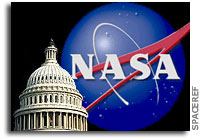AIP FYI #34: Science Committee Members Worried About NASA’s Science Budget

FYI The American Institute of Physics Bulletin of Science Policy News Number 34: March 10, 2006
Two recent hearings revealed that House Science Committee members are not pleased with NASA’s FY 2007 budget request and how it would affect the agency’s science programs. Chairman Sherwood Boehlert (R-NY) professed himself “extremely uneasy” about the request, calling it “bad for space science, worse for earth science.” The committee members seemed willing to revisit NASA’s priorities, questioning whether President Bush’s Space Exploration Initiative was the appropriate focus at the expense of science. They indicated a desire to see NASA’s total budget increased during the appropriations process. “Even as a fiscal conservative,” said Science and Aeronautics Subcommittee Chairman Ken Calvert (R-CA), “I would like to see us raise [NASA’s] topline” and not pit human exploration against robotic programs. At the same time, members continued to voice praise and support for NASA Administrator Michael Griffin.
NASA’s $16.8 billion budget request for FY 2007 would provide a 1.5 percent increase, to $5.3 billion, for science programs. However, projections for future years differ dramatically from what was laid out in last year’s request, partly to cover a shortfall in the budget for the shuttle. The FY 2007 request proposes $3.1 billion less for NASA science programs during the FY06-FY10 time period than was projected in last year’s budget, and funding growth of only one percent per year – less than the rate of inflation – over that period. This would result in funding cuts, delays, and possible cancellations of current and future science missions, as well as reductions in funding for Research and Analysis (R&A).
Speaking to the committee on February 16, Griffin described the rationale behind the budget request. In the past 15 years, he said, science programs within NASA have grown from 24 percent to 32 percent of the agency’s budget, while at the same time, NASA’s human space flight capabilities were “allowed to atrophy.” In his view, the human space flight portion of NASA was “most in need” of care right now. When asked whether it was worth damaging NASA’s science programs to “re-do what America has done before” by returning to the Moon, Griffin argued that human access to space was an important strategic asset for the nation, and stated his belief that losing such capability would be more damaging to the U.S. than delaying a number of science missions. He said he had tried to delay as much as possible within the human spaceflight program before turning to science as “my last alternative.” He characterized the current fiscal situation as a temporary “speedbump” for the next three or four years until the shuttle is replaced by the Crew Exploration Vehicle (CEV), and he reminded the committee that funding for science was still slated for an increase. “We’re not slashing science to the bone,” he said; “it’s a pretty strong budget for science.” However, others later pointed out that the outyears growth in NASA science funding proposed in the FY 2007 request would not keep pace with inflation or with the projected growth in the rest of the NASA budget.
Griffin questioned the expressions of concern now, when over the past decade, he thought science could be viewed as “cannibalizing” the human spaceflight programs. “No one complained” at the time, responded Ranking Minority Member Bart Gordon (D-TN), but “they’re complaining now.” This was amply demonstrated by the March 2 hearing, at which a panel of scientific experts criticized NASA’s science funding priorities. Griffin stated that he had tried to preserve the high-priority, flagship science missions recommended in the National Academy of Sciences’ decadal surveys of priorities in the various space and earth science disciplines. He had instead chosen to cut smaller missions and funding for R&A grants in light of the fact that constrained funding would result in lower future flight rates for science missions. However, the scientists at the later hearing agreed unanimously that this was the wrong decision: they stated that R&A grants to scientists at universities were of the highest importance in maintaining the future health of the disciplines and attracting and retaining the next generation of scientists. Griffin admitted that he had received a lot of “stakeholder feedback,” and expressed a willingness to consider shifting funds within NASA’s science budget.
The outside experts testifying at the March 2 hearing had an opportunity to air their grievances to Mary Cleave, NASA’s Associate Administrator for the Science Mission Directorate. They explained that the R&A grants supported university scientists and graduate students, and that the small, low-cost, high-frequency missions like the Explorer program were, as Joseph Taylor of Princeton University said, often “an entry point” to the field for young researchers. “It doesn’t make sense to cut the smallest and most productive stuff,” said Fran Bagenal of the University of Colorado at Boulder, and Taylor called it “counterproductive” to focus cuts “on the youngest members of the community.” Wes Huntress of the Carnegie Institution of Washington said the reductions made no sense in light of the President’s State of the Union call for greater investment in science and scientists. “In lean times,” he said, the priorities should be: research programs first and technology development for future missions second, followed by small missions, medium-sized missions, and finally the larger flagship missions.
When pressed by Boehlert, all agreed that, if more money was not found, they would choose to give up or delay larger missions and shift funds to R&A for the future health of their fields. Berrien Moore of the University of New Hampshire responded with, “been there; done that,” noting that the Global Precipitation Mission had been delayed for over two years and the earth science program had been “pared to the bone.” But he agreed that the R&A cuts were “just disastrous” and needed to be “turned around.” Taylor said he would support a reassessment of funding for the Hubble and James Webb Space Telescopes, if they “have so weakened other parts of the program that are so essential” for the future of the field. He called for NASA to restore its advisory committee structure to provide guidance on such questions. Cleave reported that NASA was trying to reconstitute its advisory committees before June. “That’s not much help,” Gordon replied, as the appropriations process would be well under way by then.
The witnesses agreed that the general priorities of the decadal surveys were still appropriate, but pointed out that the surveys called for a mix of missions of various sizes. Taylor noted that the surveys were based on cost estimates that have proven invalid. Moore said, “we started out with what we thought was a pocketbook” and ended up with “a coin purse,” and added that such instability makes prioritization efforts difficult.
“I have to say, this is probably the most depressing hearing I’ve sat through,” Gordon declared at the hearing’s end. He compared it to “trying to determine which of your children are you going to throw off the boat to save the boat,” and that it was degenerating toward “throwing all of them off to save the boat.” He added that everyone was avoiding “the elephant in the room”: reassessing how the science programs should be prioritized against the exploration initiative, especially if development of the CEV slipped and science would be continually competing against human spaceflight for funds. Boehlert, who began the hearing by saying that he wanted to do “everything in my power to protect NASA science,” concluded it by saying, “I hope you gained something from this, Dr. Cleave.”
Audrey T. Leath
Media and Government Relations Division
The American Institute of Physics
fyi@aip.org
www.aip.org/gov
(301) 209-3094









